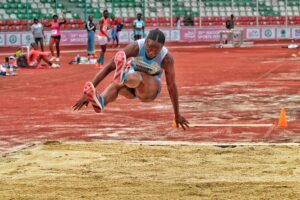Back to: Physical Health Education SS2
Welcome to today’s class!!
We are thrilled to have you in our class!!
In today’s Physical and Health Education class, we will be learning about Long Jump
Long Jump

Do you know that the objective of the long jump is simple – to cover the maximum possible distance with a horizontal jump. However, a deep dive into the details reveals the long jump is one of the most technically difficult track and field events to master.
Long Jump Rules And Techniques

Long jumpers start with a running start, propel themselves in the air at a designated launching point, also called the take-off board, and try to achieve maximum distance in the air before landing inside a sand pit.
So, the entire course consists of three parts. The runway, the take-off board and the sandpit to land in.
In official events, the runway measures 40m in length. It is similar to a running track used in sprinting, mid-distance or long-distance running events and is made out of a rubberised material laid over concrete.
At the end of the runway lies a 20cm wide take-off board. The runway and the take-off.
The end of the take-off board is marked with a foul line. While taking off, the toe of the jumper’s shoe needs to be behind the foul line for a particular jump to be deemed legal. Crossing the line results in a foul jump and doesn’t count.
After being airborne, the jumper lands in the sandpit placed on the other side of the take-off board.
The distance covered, from the edge of the take-off board to the indentation in the sand (made by any part of the athlete’s body while landing) closest to the take-off board, is measured.
The entire jump needs to be completed within one minute after the long jumper steps into the runway. Long jumpers are allowed to wear spikes if they prefer but the sole of their shoe cannot be more than 13mm thick.
At events, an athlete is often given a fixed number of attempts and the one with the longest distance covered, is counted as the best.
In the final rounds of big competitions like the Olympics or World Championships, athletes generally get six jumps. A set of three trial round jumps are held to select the finalists, who then get three more jumps to win medals in the final.
Sail – The most basic one of the lot, the sail involves the jumper immediately lifting their legs into a toe-touching position after take-off. This allows the body to float or sail in the air longer with the momentum achieved during take-off.
Hang – This technique involves stretching the body and making it as long as possible after being airborne. Both arms and legs are extended to reach the maximum distance possible and the position is maintained until the jumper reaches the highest elevation.
At the apex, the jumper shifts their legs forward into a landing position.
Hitch-kick – Also called climbing or running in the air, the athletes rotate their arms and legs during the flight to maintain balance. This is the most complex of the three techniques.
In summary, the long jump is one of the sport games in track and field events difficult to master, requiring consistent practice.
Evaluation
What is Long Jump in Physical Education?
Reading Assignment
Explain four Rules and Techniques in High Jump
Weekend Assignment
Explain how High Jump Pole Vault differs from Long Jump
We hope you enjoyed today’s class. In our next class, we will be talking about Triple Jump.
Let us know your thoughts and questions in the comment section, and we will attend to them as fast as we can.
